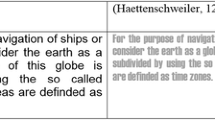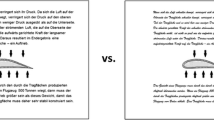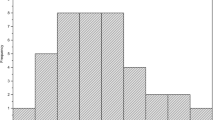Abstract
In some cases difficult-to-read learning materials lead to better performance than easy to-read materials. This phenomenon is called the disfluency effect and is attributed to a subjective feeling of task difficulty resulting in a deeper learning approach. In two studies (n1 = 67, n2 = 73) we investigated the impact of three increasing disfluency levels compared to a fluent condition on learning outcomes, in the second study we additionally addressed effects on cognitive load and time on task. The first study revealed significant differences of the experimental groups and on a descriptive level a reversed u-shape pattern, i.e., learning performance increases with increasing disfluency but decreases when the text becomes too illegible. The same pattern could be found significantly in the second study for recall and transfer performance, engagement and time on task and the reversed pattern for extraneous load. Results indicate that there is in fact an optimal level of disfluency on performance that comes along with increased engagement and that there is a breaking point of disfluency where the extraneous load seems to be too high.



Similar content being viewed by others
References
Alter, A. L., & Oppenheimer, D. M. (2009). Uniting the tribes of fluency to form a metacognitive nation. Personality and Social Psychology Review, 13, 219–235.
Alter, A. L., Oppenheimer, D. M., Epley, N., & Eyre, R. (2007). Overcoming intuition: Metacognitive difficulty activates analytic reasoning. Journal of Experimental Psychology, 136, 569–576.
Bannert, M. (2002). Managing cognitive load—Recent trends in cognitive load theory. Learning and Instruction, 12, 139–146.
Bjork, R. A. (1994). Memory and metamemory considerations in the training of human beings. In J. Metcalfe & A. Shimamura (Eds.), Metacognition: Knowing about knowing (pp. 185–205). Cambridge, MA: MIT Press.
Bless, H., Wänke, M., Bohner, G., Fellhauer, R. F., & Schwarz, N. (1994). Need for cognition: eine Skala zur Erfassung von Engagement und Freude bei Denkaufgaben. Zeitschrift für Sozialpsychologie, 25, 147–154.
Cacioppo, J. T., & Petty, R. E. (1982). The need for cognition. Journal of Personality and Social Psychology, 42, 116–131.
Corley, M., MacGregor, L. J., & Donaldson, D. I. (2007). It’s the way that you, er, say it: Hesitations in speech effect language comprehension. Cognition, 105, 658–668.
Craik, F., & Tulving, E. (1975). Depth of processing and the retention of words in episodic memory. Journal of Experimental Psychology, 104, 268–294.
Diemand-Yauman, C., Oppenheimer, D. M., & Vaughan, E. B. (2011). Fortune favors the bold (and the italicized): Effects of disfluency on educational outcomes. Cognition, 118, 114–118.
Eitel, A., & Kühl, T. (2016). Effects of disfluency and test expectancy on learning with text. Metacognition and Learning, 11, 107–121. doi:10.1007/s11409-015-9145-3.
Eitel, A., Kühl, T., Scheiter, K., & Gerjets, P. (2014). Disfluency meets cognitive load in multimedia learning: Does harder-to-read mean better-to-understand? Applied Cognitive Psychology, 28, 488–501.
Ekstrom, R. B., French, J. W., & Harmann, H. H. (1976). Manual for kit of factor-referenced cognitive tests. Princeton, NJ: Educational Testing Service.
French, M. M. J., Blood, A., Bright, N. D., Futak, D., Grohmann, M. J., Hasthorpe, A., et al. (2013). Changing fonts in education: How the benefits vary with ability and dyslexia. The Journal of Educational Research, 106, 301–304. doi:10.1080/00220671.2012.736430.
Hogan, R. M., & Kintsch, W. (1971). Differential effects of study and test trials on long-term recognition and recall. Journal of Verbal Learning and Verbal Behavior, 10, 562–567.
James, W. (1950). The Principles of Psychology. New York: Dover. (Original work published 1890).
Kalyuga, S. (2005). Prior knowledge principle in multimedia learning. In R. Mayer (Ed.), The Cambridge handbook of multimedia learning (pp. 325–338). Cambridge, New York: Cambridge University Press.
Kalyuga, S., & Singh, A. (2015). Rethinking the boundaries of cognitive load theory in complex learning. Educational Psychology Review. doi:10.1007/s10648-015-9352-0.
Kapur, M. (2008). Productive failure. Cognition and Instruction, 26, 379–424.
Klepsch, M., & Seufert, T. (2012). Subjective differentiated measurement of cognitive load. Paper presented at 5th international cognitive load theory conference, Tallahassee, USA.
Kühl, T., & Eitel, A. (2016). Effects of disfluency on cognitive and metacognitive processes and outcomes. Metacognition and Learning, 11, 1–13.
Kühl, T., Eitel, A., Damnik, G., & Körndle, H. (2014). The impact of disfluency, pacing, and students’ need for cognition on learning with multimedia. Computers in Human Behavior, 35, 189–198.
Lehmann, J., Goussios, C., & Seufert, T. (2016). Working memory capacity and disfluency effect: An aptitude-treatment-interaction study. Metacognition and Learning, 11, 89–105. doi:10.1007/s11409-015-9149-z.
Leppink, J., Paas, F., van der Vleuten, C., van Gog, T., & van Merrienboer, J. (2013). Development of an instrument for measuring different types of cognitive load. Behavior Research Methods, 4, 1058–1072. doi:10.3758/s13428-013-0334-1.
Mayer, R. E. (2014). Cambridge handbook of multimedia learning (2nd ed.). Cambride: Cambridge University Press.
Mengelkamp, C., Pieger, E., & Bannert, M. (2015). Using eye-tracking to investigate the effects of disfluency on metacomprehension. Paper presented at the 16th EARLI Conference for research on learning and instruction: synergies between learning, teaching and research, Limassol, Cyprus.
Moreno, R. (2005). Instructional technology: Promise and pitfalls. In L. PytlikZillig, M. Bodvarsson, & R. Bruning (Eds.), Technology-based education: Bringing researchers and practitioners together (pp. 1–19). Greenwich, CT: Information Age Publishing.
Oberauer, K., Süß, H.-M., Schulze, R., Wilhelm, O., & Wittmann, W. W. (2000). Working memory capacity—facets of a cognitive ability construct. Personality and Individual Differences, 29, 1017–1045.
Oppenheimer, D. M., & Alter, A. L. (2014). The search for moderators in disfluency research. Applied Cognitive Psychology, 28, 502–504.
Reber, R., & Schwarz, N. (1999). Effects of perceptual fluency on judgments of truth. Consciousness and Cognition, 8, 338–342.
Rheinberg, F., Vollmeyer, R., & Burns, B. D. (2001). QCM: A questionnaire to assess current motivation in learning situations (original title: FAM: Ein Fragebogen zur Erfassung aktueller Motivation in Lern-und Leistungssituationen). Diagnostica, 47, 57–66.
Rhodes, M. G., & Castel, A. D. (2008). Memory predictions are influenced by perceptual information: Evidence for metacognitive illusions. Journal of Experimental Psychology, 137, 615–625.
Schnotz, W., & Bannert, M. (1999). Einflüsse der Visualisierungsform auf die Konstruktion mentaler Modelle beim Text- und Bildverstehen. Zeitschrift für Experimentelle Psychologie, 46, 217–236.
Schwartz, D., & Bransford, J. D. (1998). A time for telling. Cognition and Instruction, 16, 475–522.
Seufert, T. (2003). Supporting coherence formation in learning from multiple representations. Learning and Instruction, 13, 227–237.
Song, H., & Schwarz, N. (2008). Fluency and the detection of misleading questions: Low processing fluency attenuates the Moses illusion. Social Cognition, 26, 791–799.
Sungkhasettee, V. W., Friedman, M. C., & Castel, A. D. (2011). Memory and metamemory for inverted words: Illusions of competency and desirable difficulties. Psychonomic Bulletin & Review, 18, 973–978.
Sweller, J. (2010). Element interactivity and intrinsic, extraneous, and germane cognitive load. Educational Psychology Review, 22, 123–138.
Sweller, J., Ayres, P., & Kalyuga, S. (2011). Cognitive load theory. New York: Springer.
Sweller, J., van Merrienboer, J. J., & Paas, F. G. (1998). Cognitive architecture and instructional design. Educational Psychology Review, 10, 251–296.
Tverski, A., & Kahneman, D. (1974). Judgment under uncertainty: Heuristics and biases. Science, 185, 1124–1131.
Yue, C. L., Castel, A. D., & Bjork, R. A. (2013). When disfluency is—and is not—a desirable difficulty: The influence of typeface clarity on metacognitive judgments and memory. Memory and Cognition, 41, 229–241.
Acknowledgments
We especially thank Wolfgang Schnotz and Maria Bannert for providing us the learning material of the second study in addition to all the conceptual thoughts we could learn from them. We also thank Nina Singer and Verena Fritz for their support in conducting the study. Moreover, we appreciate the very thoughtful comments of two anonymous reviewers who helped us to improve the paper.
Author information
Authors and Affiliations
Corresponding author
Rights and permissions
About this article
Cite this article
Seufert, T., Wagner, F. & Westphal, J. The effects of different levels of disfluency on learning outcomes and cognitive load. Instr Sci 45, 221–238 (2017). https://doi.org/10.1007/s11251-016-9387-8
Received:
Accepted:
Published:
Issue Date:
DOI: https://doi.org/10.1007/s11251-016-9387-8




